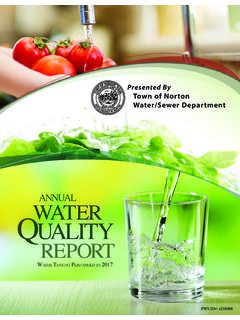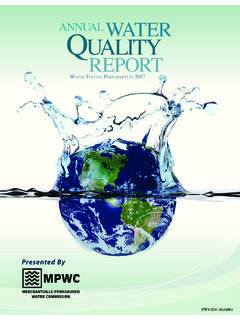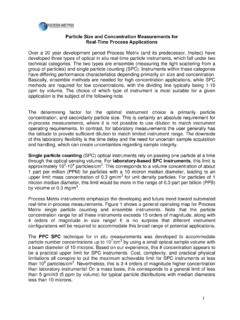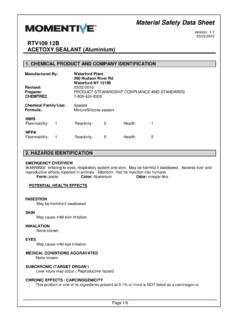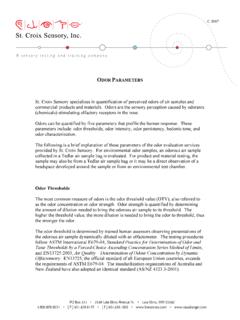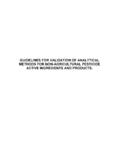Transcription of City of Vineland Water Utility - gemgrp.com
1 Presented By city of Vineland Water Utility PWSPWS. ID#:ID#: XX. 0614003. Meeting the Challenge Substances That Could Be in Water O nce again we are proud to present our annual drinking Water report, covering all drinking Water testing performed between January 1 and December 31, T o ensure that tap Water is safe to drink, the EPA prescribes regulations limiting the amount of certain contaminants in Water provided by public Water 2015. Over the years, we have dedicated ourselves to systems. Food and Drug Administration regulations producing drinking Water that meets all state and federal establish limits for contaminants in bottled Water that standards. We continually strive to adopt new methods must provide the same protection for public health. for delivering the best-quality drinking Water to your Drinking Water , including bottled Water , may reasonably homes and businesses.
2 As new challenges to drinking be expected to contain at least small amounts of some Water safety emerge, we remain vigilant in meeting the contaminants. The presence of these contaminants does goals of source Water protection, Water conservation, not necessarily indicate that the Water poses a health risk. and community education while continuing to serve the The sources of drinking Water (both tap Water and bottled needs of all of our Water users. Water ) include rivers, lakes, streams, ponds, reservoirs, Please remember that we are always available to assist springs, and wells. As Water travels over the surface of you, should you ever have any questions or concerns the land or through the ground, it dissolves naturally about your Water . occurring minerals, in some cases, radioactive material, and substances resulting from the presence of animals or from human activity.
3 Substances that may be present in source Water include: Community Participation Microbial Contaminants, such as viruses and bacteria, Y ou are invited to participate in our public forum and voice your concerns about your drinking Water . The Vineland city Council meets the second and fourth which may come from sewage treatment plants, septic systems, agricultural livestock operations, or wildlife;. Inorganic Contaminants, such as salts and metals, which Tuesdays of each month beginning at 6 at city can be naturally occurring or may result from urban Hall, Seventh and Wood Streets, Vineland , New Jersey. stormwater runoff, industrial or domestic wastewater discharges, oil and gas production, mining, or farming;. Pesticides and Herbicides, which may come from a Where Does My Water Come From? variety of sources such as agriculture, urban stormwater runoff, and residential uses.
4 T he city of Vineland Water Utility 's customers are fortunate because we enjoy an abundant Water supply from groundwater. Our groundwater supply is Organic Chemical Contaminants, including synthetic and volatile organic chemicals, which are by-products not exposed to air and is not subject to direct pollution of industrial processes and petroleum production and and contamination as a river or reservoir would be. In may also come from gas stations, urban stormwater fact, groundwater is the highest-quality Water available runoff, and septic systems;. to meet the public health demand of Water intended for Radioactive Contaminants, which can be human consumption. naturally occurring or may be the result of All 13 municipal wells draw Water from the Kirkwood- oil and gas production and mining Cohansey aquifer at depths ranging from 160 feet to activities.
5 200 feet. This aquifer holds an estimated 17 trillion For more information about gallons of Water beneath the pristine Pinelands, a contaminants and potential health million-acre protected reserve. Combined, our pumping effects, call the EPA's Safe and treatment facilities can provide roughly billion Drinking Water Hotline at (800). gallons of drinking Water every year. 426-4791. Lead in Home Plumbing I f present, elevated levels of lead can cause serious health problems, especially for pregnant women and young children. Lead in drinking Water is primarily from materials and components associated with service lines and home plumbing. We are responsible for providing high-quality drinking Water , but we cannot control the variety of materials used in plumbing components. When your Water has been sitting for several hours, you can minimize the potential for lead exposure by flushing your tap for 30 seconds to 2 minutes before using Water for drinking or cooking.
6 If you are concerned about lead in your Water , you may wish to have your Water tested. Information on lead in drinking Water , testing methods, and steps you can take to minimize exposure is available from the Safe Drinking Water Hotline or at Protecting Your Water Source: What Is SWAP? S WAP (Source Water Assessment Plan) is a program of the New Jersey Department of Environmental Protection (NJDEP) for the study of existing and potential threats to the quality of public drinking Water sources throughout the state. Sources are rated depending upon their contaminant susceptibility. The NJDEP has completed and issued the Source Water Assessment Report and Summary for this public Water system, which is available at or by contacting NJDEP's Bureau of Safe Drinking Water at (609) 292-5550. You may also contact Michael S.
7 Lawler at (856) 794-4056. RADIONUCLIDES. DISINFECTION. PRECURSORS. COMPOUNDS. BY-PRODUCT. INORGANICS. PATHOGENS. PESTICIDES. NUTRIENTS. ORGANIC. VOLATILE. RADON. Sources H M L H M L H M L H M L H M L H M L H M L H M L. Wells 13 4 9 11 2 9 4 12 1 7 6 13 13 1 12. If a system is rated highly susceptible for a contaminant category, it does not mean a customer is or will be consuming contaminated drinking Water . The rating reflects the potential for contamination of source Water , not the existence of contamination. Public Water systems are required to monitor for regulated contaminants and to install treatment if any contaminants are detected at frequencies and concentrations above allowable levels. As a result of the assessments, NJDEP. may customize (change existing) monitoring schedules based on the susceptibility ratings.
8 Source Water protection is a long-term dedication to clean and safe drinking Water . It is more cost effective to prevent contamination than to address contamination after the fact. Every member of the community has an important role in source Water protection. NJDEP recommends controlling activities and development around drinking Water sources whether it is through land acquisition, stormwater drain protection, or hazardous waste collection programs. How Is My Water Treated and Purified? T he treatment process consists of a series of steps. First, raw Water is drawn from the Kirkwood-Cohansey aquifer by vertical turbine well pumps and is sent to an aerator, which oxidizes the iron levels that are present in the Water and raises the pH. Some wells pass the raw Water through filters on the way to the aerator to remove nitrate or radium, and some pass raw Water through an air stripper to remove volatile organic compounds.
9 The Water then goes to a mixing tank where lime, chlorine, and a corrosion inhibitor (used to protect distribution system pipes) are added before the Water is pumped to sanitized Water towers and into your home or business. Fixtures with Green Stains Information on the Internet A green or blue-green stain on kitchen or bathroom fixtures is caused by tiny amounts of copper that dissolve in your home's copper plumbing system when T he EPA ( Water ) and Centers for Disease Control and Prevention ( ). the Water sits unused overnight. Copper staining may be Web sites provide information on many issues the result of a leaky faucet or a faulty toilet flush valve, so relating to Water resources, Water conservation, and be sure your plumbing is in good working order. public health. Also, the New Jersey Division of Copper stains may also be caused by overly hot tap Water Supply and Geoscience Web site ( Water .)
10 Generally speaking, you should maintain your ) provides complete and current Water temperature at a maximum of 120 degrees information on Water issues in New Jersey, including Fahrenheit. You should consult the owner's manual valuable information about our watershed. for your heater or check with your plumber to determine your current heat setting. Lowering your Water temperature will Questions? reduce the staining problem and save you money on your energy bill. Also keep in mind that a tap that is used often For more information about this report, or throughout the day usually will not produce for any questions relating to your drinking copper stains, so if you flush the tap for a Water , please call Michael S. Lawler, minute or so before using the Water for cooking Superintendent, at (856) 794-4056. or drinking, copper levels will be reduced.

